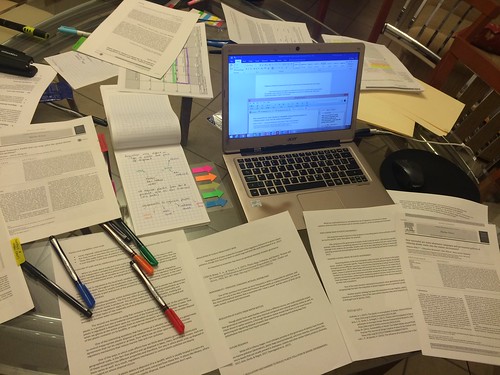My conversations on Twitter with Dr. Pat Thomson (The University of Nottingham) are always delightful. Pat is someone I deeply admire for her research and her commitment to graduate students and scholarly collegiality. I have had the fortune of interacting with her on a regular basis and she’s someone whose blog I refer my own students and research assistants as well as just about everybody who follows me on Twitter. Several times, Pat has emphasized the importance of developing “repertoires”. She is entirely right.
As a former competitive dancer, classical piano player and overall, someone who doesn’t believe that “one size fits all”, I am all about the repertoires.
Let me start by mentioning that I feel very, very, very strongly that we need to teach our students and colleagues that there is a broad range of reading strategies and heuristics, much in the same way that there are diverse writing repertoires, various rhetorical moves, etc.
— Dr Raul Pacheco-Vega (@raulpacheco) August 23, 2019
(I blogged about this here https://t.co/tX2pI1qUpW)
HOWEVER, I do feel we need to teach our students, in particular our undergraduate students, to READ IN DEPTH *before* we teach them how to skim.
We also need to show them how we “triage” our reading https://t.co/BqSpnoLfiL
— Dr Raul Pacheco-Vega (@raulpacheco) August 23, 2019
When I blogged about comprehensive/qualifying exams, I explained that their purpose (at least, when and where *I* did my PhD) was to demonstrate competence, breadth AND depth. https://t.co/3SbJCv3kgi this means, yes, kids, reading in depth. Not everything, but A LOT OF STUFF.
— Dr Raul Pacheco-Vega (@raulpacheco) August 23, 2019
It is important that our students learn diverse mid- or meso-level, or in-depth reading strategies https://t.co/nJFSmuJNBm I am developing blog posts to teach my undergraduate students a few heuristics for reading (by topic sentence, by keyword scan, etc) https://t.co/0Dnb2ITySI
— Dr Raul Pacheco-Vega (@raulpacheco) August 23, 2019
But as I have said, reading takes time, as does doing good research.
… find ways to help. This is why it bothers me when people think that academics are somehow lazy. We HAVE to spend A LOT OF TIME reading, analyzing, thinking, writing. Our students do, our research assistants do, contingent faculty do, everyone in academia has to spend TIME.
— Dr Raul Pacheco-Vega (@raulpacheco) August 23, 2019
This is why I developed an entire page on Reading Strategies (and more recently, one on Reading Strategies for Undergraduate Students). Because while you don’t need to Read All The Things in depth, you DO need to read SOME of those things quite deeply.
The repertoire needs to vary, almost as much as the material does. And as I’ve written before, you develop heuristics to triage your reading material by…
… well…
Reading. And again, doing more reading. And even more reading.
There is no substitute for practice, unfortunately. This is true in academia and in everything else. Hopefully this blog post and my Resources pages will help others develop their own robust repertoire of reading strategies.



0 Responses
Stay in touch with the conversation, subscribe to the RSS feed for comments on this post.